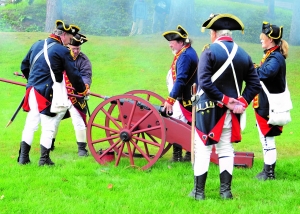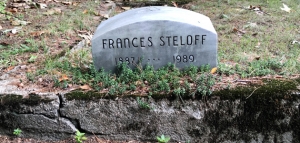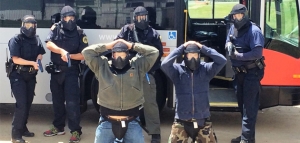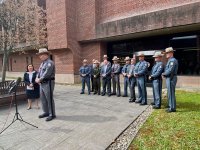More than 200 Celebrate Anniversary of American Victory at Schuylerville
SCHUYLERVILLE — More than 200 area residents, school children, historians and re-enactors gathered on the west bank of the Hudson River Monday morning to celebrate a pivotal anniversary in the birth of the nation.
“Exactly 239 years ago on this very day, in this very place and on this ground where we stand, America had its first victory of the Revolutionary War,” said Amy Bracewell, superintendent at Saratoga National Historical Park and keynote speaker of the Surrender Day gathering at Fort Hardy Park. “This created a snowball effect in the creation of this country.”
The park marks the location where 5,000 British soldiers, accompanied by the lonely beat of a drum, surrendered their arms on the morning of Oct. 17, 1777, following the colonial victories at the battles of Saratoga.
Dressed as members of the Continental Army, a half-dozen re-enactors fired off a booming cannon salute, members of the Daughters and the Sons of the American Revolution presented a laying of wreaths, and a changing of the flags ceremony symbolized American freedom from British rule.
“Our nation was founded on a bold new idea: that a free people in participatory democracy were in the best position to chart the future,” said Democrat Assemblywoman Carrie Woerner, who represents the 113th district of New York. Schuylerville Central School District students Tucker Durr and Madelynn Solan read essays about key figures of the Revolutionary War, and the school’s fifth-grade chorus sang “Yankee Doodle Dandy,” and “My Country ‘Tis Of Thee.” Students from Salem Central School also attended the ceremony.
A re-enactment of the sword surrender – which occurred a short distance away on state Route 4 - was performed by Saratoga Battlefield Park Ranger and Historian Eric Schnitzer, and Saratoga Town Historian Sean Kelleher, respectively portrayed British Gen. John Burgoyne and colonial Gen. Horatio Gates.
Notes From City Hall: Code Blue Heading to Caroline
SARATOGA SPRINGS — Emergency Shelter Relocation To Caroline Street Appears Set
After spending the past two winters at the Salvation Army building on Woodlawn Avenue, programming conflicts brought on by Gov. Andrew Cuomo’s Executive Order mandating that shelters stay open for longer hours necessitated that Code Blue Saratoga find a new location to house its emergency shelter. More than two dozen potential venues were investigated by Shelters of Saratoga – the agency which oversees Code Blue - before Soul Saving Station in September agreed to allow the shelter to operate at its facility on Caroline and Henry streets from Nov. 1 to April 1, 2017.
Some local business-owners and home-owners located in the Caroline Street area where the shelter would be relocated subsequently voiced concerns regarding safety issues and increased costs and urged the Salvation Army to reconsider and host Code Blue for a third year. The extended hours mandated for shelter use, however, caused the Salvation Army last winter to close its after-school program for at-risk youth – which has operated for 20 years - and affected more than two dozen children, according to a person close to the organization. The person spoke on condition of anonymity because they were not authorized to release that information late Wednesday night.
Due to the loss of core programming last winter and the continued loss of programming that would occur in the future, the person said the housing of the Code Blue shelter at the Salvation Army was always meant to be a temporary solution, but that the Salvation Army continues working with Code Blue to assist in other ways, such as offering the use of shower facilities and providing breakfast for the homeless population. The emergency shelter is slated to open Nov. 1 and appears be headed for the Caroline Street location.
A community forum regarding Code Blue Saratoga’s 2016-17 season will be held at noon Tuesday, Oct. 25 at the Saratoga Springs Public Library, 49 Henry St. The forum will include “an overview of the Code Blue Saratoga program and its policies, followed by a facilitated discussion regarding the upcoming season,” according to a statement released by the organization Friday.
Should the council hold public hearings on whether it is in favor, or opposed to Saratoga Springs hosting the gun show?
That’s what one local resident is suggesting. “What I think the City Council needs to do, is take this issue seriously,” local resident David Bronner told council members this week, during the public comment section of the council meeting. “Craft a resolution about the gun show and how you feel about it. Hold public hearings on it, debate it, and vote on it.”
After organizing more than 100 gun shows at the Saratoga Springs City Center over the past 32 years, show promoter David Petronis was informed last summer that the venue would not have any open dates to host the show in the near future, because a greater priority had been placed on securing conference and convention business. Last year, the City Center hosted 75 conferences and conventions, 48 special events or banquets, and 31 gate or trade shows, such as the gun fair. All of these events combined had an attendance of 155,000 people. The City Center’s management officially is independent of city government and to date, the City Council has not officially debated the issue.
A Plan For Going Wireless
A short video was screened and a 70-page booklet distributed at City Hall this week showcasing Saratoga Springs’ Smart City Roadmap. Among the initiatives: a plan to deliver wireless broadband in public spaces to keep residents as well as visitors connected. The Smart City Project Team meets quarterly and Michele Madigan, city representative of the Smart City team, said the commission will begin to tackle plan initiatives in 2017. The roadmap was also posted on the city’s website and may be viewed by visiting: http://www.saratoga-springs.org/DocumentCenter/View/5157.
Public: Protect Character Of Existing Neighborhoods
A zoning diagnostic report was presented to the City Council Tuesday night. The report indicates a strong public desire to protect the character of existing neighborhoods, an enthusiasm to preserve historic structures and an expressed concern over the commercialization of residential neighborhoods. A copy of the October 18 presentation of the Zoning Diagnostic Report may be viewed by visiting: https://saratogaspringsudo.com/.
Budget Hearings
The first of two public hearings regarding the city’s proposed 2017 Comprehensive Budget was staged Tuesday night. No one from the public chose to address the council regarding the spending plan, which may be viewed at: http://www.saratoga-springs.org/DocumentCenter/Home/View/5059. The second public hearing will be held Tuesday, Nov. 1 prior to the 7 p.m. City Council meeting.
Complete Streets
Mayor Joanne Yepsen announced the draft copy of the city’s Complete Streets Plan is available for public review at: http://www.saratogaspringscompletestreets.com/. The goal of the plan is to improve safety, connectivity, and accessibility for pedestrians, bicyclists, motorists and transit users in city neighborhoods, by incorporating the needs of all modes of transportation.
Zombie Properties
Public Safety Commissioner Chris Mathiesen announced the city was awarded a $150,000 grant from the state Attorney General to address vacant and “zombie” properties. The remediation and prevention initiative will include the hiring of a part-time officer and the department will use a multi-tiered approach to identify vacant properties that owe taxes and those that are in disrepair, and issue citations to enforce measures.
Overriding The Tax Cap
The Saratoga County Board of Supervisors this week decided to delay a vote on whether to override the 2 percent property tax cap in 2017. Only two area residents addressed the board during Tuesday’s meeting in Ballston Spa. The vote is expected to take place next month, said city Supervisor Matthew Veitch.
Upcoming Meetings
The Zoning Board of Appeals will host a meeting 7 p.m. Monday, Oct. 24 at City Hall. The Charter Review Commission will host a meeting 6:30 p.m. Tuesday, Oct. 25 at City Hall. The Planning Board will host a meeting 7 p.m. Thursday, Oct. 27 at City Hall. The pre-meeting workshop will take place 5 p.m. Monday.
Notes from City Hall: Going Wireless Downtown
Artists Raise Funds For Preservation
SARATOGA SPRINGS — A portrait of ladies lunching at a Broadway café stood near a framed sketch of a pair of pink ballet slippers.
Landscapes of Yaddo, the racecourse and Universal Preservation Hall were accompanied by displays of Caffe Lena, Congress Park and an abundance of thoroughbreds portrayed in oil, watercolor, and digital print.
More than 140 different art works inspired by the spirit of Saratoga Springs were exhibited inside the historic Canfield Casino, depicting a varied vision through the eyes of 60 different artists. The inspiration of the exhibit was the 2016 TRASK Art Show and Sale, a popular art auction that provides vital funding for the Saratoga Springs Preservation Foundation in their ongoing efforts to preserve Saratoga Springs through restoration projects. Those efforts include the recent successful completion of the restoration of the Spirit of Life and Spencer Trask Memorial in Congress Park – a piece initially commissioned by Katrina and George Foster Peabody, after Spencer Trask’s death in 1909.
Spencer is largely credited with preserving the Spa’s spring waters, and along with wife Katrina bequeathed their 55-room mansion and adjoining grounds on Union Avenue to artists of all kinds. Since 1926, their Yaddo estate has welcomed more than 6,000 visiting artists.
Ironically, Trask’s anti-gambling stance put him at odds with John Morrissey, who established his gaming house in Congress Park and the venue where the TRASK Art Show and Sale was staged. A $500 prize for Best in Show was awarded to Matt Chinian for his oil and canvas display titled: Juniper Swamp.
“I’ve been doing this a long time and selling paintings is nearly impossible, so this is a big boost,” said the artist from Cambridge, who specializes in painting outdoor scenes. Artists Robert Whiting Chris O’Leary and Dave Papa each received honorable mention. Ian Berry, director of the Tang Teaching Museum and Art Gallery at Skidmore College, and Kathy Greenwood, director of the Art and Culture Program at Albany International Airport, served as show judges. Artists received 50 percent of their artwork’s sale price, with the balance of sales benefiting restoration projects and ongoing efforts to preserve Saratoga Springs. The event was attended by 250 people. A final tally of funds raised during the event was not yet available.
Red Flags For Code Blue
SARATOGA SPRINGS — One week after Shelters of Saratoga announced an agreement to site the Code Blue Saratoga emergency shelter on Caroline and Henry streets, the 11th-hour solution has drawn the ire of some local residents and business owners who say they were not informed of the shelter’s relocation to the east side neighborhood and expressed concerns about potential safety issues.
After spending the past two winters at the Salvation Army building on Woodlawn Avenue, scheduling conflicts at the Salvation Army necessitated that Code Blue Saratoga find a new location to house its emergency shelter. More than two dozen potential venues were investigated before Soul Saving Station agreed to allow the shelter to operate at its facility on Caroline and Henry streets from Nov. 1 to April 1, 2017.
“That location is a perfect storm of what can go wrong,” said Franesa Pyle, owner of Saratoga Botanicals on Henry Street. “It’s the safety of the children we have to consider.”
The proximity to the city’s densest bar district, as well as to the children’s museum, the public library, and school walk-to zones poses a problem, say critics of the relocation. “We weren’t given a voice to be part of the solution, or we would have expressed our concerns at that time,” said Michelle Smith, executive director of The Children’s Museum, on Caroline Street. “The museum supports the needs of the community - the homeless, the children, the families – we’re very sensitive to the complicated issues we face and we want to be part of the solution to make sure everyone has their needs met,” Smith added. “Where the complexity comes in for this location is that it’s directly between the museum entrance parking lot and the library. We need to make sure our patrons feel safe and secure coming to the museum.”
A three-page “summary of concerns” was presented to city Mayor Joanne Yepsen and a meeting was convened Friday at City Hall with nearly two dozen local business owners and residents. Yepsen, Public Safety Department Deputy Eileen Finneran, Shelters of Saratoga Director Michael Finocchi and Police Chief Greg Veitch were in attendance to listen to grievances during the 60-minute meeting. Questions were raised about whether Code Blue residents would be screened for sex offender status, complaints made about increased costs that would be associated with increased lighting and cameras for better street visibility, private police guards, and the clean-up of increased debris, and requests heard that a closed-door curfew be instituted at the shelter as early as 7 p.m. City Police Chief Greg Veitch responded that an increased police presence would be visible, and Finocchi indicated S.O.S. may be open to the idea of an earlier curfew - previously targeted as midnight and which could potentially be changed to 10 p.m.
Members of the east side community said they are mobilizing as a group and urging that the Salvation Army reconsider and agree to host Code Blue for another winter as a short-term solution, while the group becomes more involved in finding a permanent, long-term solution.
“I think it’s a great program and we need something like this in the community, but it landed on us without warning. We didn’t get any notice and it was quite a surprise,” Pyle said. “It would be great if the Salvation Army can take it back this season, so we can then look at some solutions in the long-term.”
The largest issue in designating a permanent home for Code Blue is financial. No city funds have been used to operate the shelter, and while no one has yet to raise the idea of spending tax dollars on a permanent facility, other communities are exploring the possibilities. In Colorado, the city of Aurora recently tabbed $1.5 million of its cannabis tax revenues to be used for homeless programs, and in Los Angeles, California, the City Council voted to place a bond measure before voters on the November ballot to raise money to fight homelessness.
In each of the past two years, the Code Blue Saratoga shelter was open more than 80 nights providing more than 3,054 and 3,344 overnight stays, respectively, in addition to more than 1,700 others provided dinner during the winter seasons of 2014-15 and 2015-16. The days of operation are anticipated to increase given new state mandates which require shelters to open when temperatures dip below 32 degrees Fahrenheit. Previously, Code Blue operated at a threshold of below 20 degrees.
“We’re opening on Nov. 1 – somewhere,” said Mayor Yepsen, explaining the search for other potential facilities proved unsuccessful due to factors such as affordability and date availability. “If anyone has any suggestions, let us know.” It appears the Caroline Street location will serve as Code Blue’s winter home should no other venue be brought into the mix during the next few weeks. “If nothing happens, we’ll still have a place,” said Mike Finocchi. “Like the mayor said, it’s going to be somewhere.”
Notes From City Hall
SARATOGA SPRINGS — The city’s proposed operating budget in 2017 will top $45.5 million – an approximate three percent increase over 2016 – but will contain no increase in taxes for city taxpayers, according to the proposal released by city Finance Commissioner Michele Madigan this week.
The $45.52 million plan marks an increase of $1.51 million over the 2016 budget, with contractual wages and health insurance accounting for nearly all of the change. Main revenue sources supporting the operating budget remain largely the same as 2016 - little to no increase is anticipated for sales tax, mortgage tax, state aid, or video-lottery terminal aid (VLT). VLT is budgeted about $498,000 higher than in years past to reflect the amount received for each of the past three years ($2.325 million).
“In the face of large and obligatory expense increases and otherwise flat revenues, this is not the year to leave money on the table,” Madigan said, in a statement.
The 2017 Budget counts both reserve funds and fund balance among its revenue resources. Amounts supporting the general operating budget include funds from unassigned fund balance ($541,000), the Retirement Reserve ($300,000) and the Tax Stabilization Reserve ($775,000).
“With no new revenue sources, little revenue growth, an almost 8 percent increase in health care costs, I can think of few better circumstances to use this reserve. It was created for this purpose. It is funded with taxpayer dollars. Taxpayers deserve to use their reserve rather than pay more taxes or receive diminished services,” Madigan said. The Council last month voted unanimously in favor of using up to about half of the reserve. This is the fifth city budget put forth by Madigan that contains virtually no increase in property tax and the 2017 budget year marks the sixth time municipalities are required to remain under the state property tax cap. Public budget workshops will take place: 1 p.m. on Wednesday Oct. 12; Wednesday, Oct. 19, and Monday, Oct. 24. A Public Comment period will also be provided during each workshop. The first of two public hearings will take place at 6:45 p.m. on Tuesday, Oct. 18. The council must adopt a budget by Nov. 30; if it doesn’t, the proposed comprehensive budget will become the 2017 adopted budget. The 2017 budget proposal can be viewed on the city’s website at www.saratoga-springs.org.
City Requests Resident Feedback For Open Space Plan
The city of Saratoga Springs is conducting a survey to update its Open Space Plan and asks residents to participate in a survey regarding their needs and concerns as it relates to open space and future open space planning. “Open Space” in the survey is defined as: public and privately-owned undeveloped lands which are important for a variety of reasons, including recreation, conservation, water resource protection, agriculture, forestry, or simply because of their scenic qualities and their contribution to the overall character of the town. To take the survey, go to: https://www.surveymonkey.com/r/X62W7JX
Weibel Ave. Not What It Used To Be
“Weibel Avenue has changed dramatically. It’s no longer the rural road it used to be,” said Public Safety Commissioner Chris Mathiesen, referencing a plan to lower the speed limit from 40 to 30 mph on Weibel, from Lake Avenue to the city line on Louden Road. A public hearing regarding the proposal will take place Oct. 18 with a potential City Council vote to follow later in the evening.
Key Figure In Comics Subculture To Deliver Steloff Lecture at Skidmore
SARATOGA SPRINGS — Frances Steloff was two months old when one of the worst blizzards in American history battered the northeast, killing more than 400 people and dropping nearly six feet of snow on Saratoga Springs.
Steloff was born on New Year’s Eve in 1887 and on her 100th birthday was presented the keys to the city by Saratoga Springs Mayor Ellsworth Jones. In the time between, she helped launch a literary foundation whose repercussions are being felt around the world, still. Young Frances grew up on the west side of Saratoga, the clamor of the Delaware & Hudson Railroad rumbling outside her bedroom window. On summer days in turn-of-the-century Saratoga Springs, she sold flowers to tourists at the Grand Union Hotel. At 19, Steloff ran off to New York City and in 1920 opened her bookstore - the Gotham Book Mart - on the city’s west side. Over the next 60 years she earned a reputation as a courageous force in the business of words.
Steloff battled with censors and sold in her store then-banned books penned by James Joyce, D. H. Lawrence, and Henry Miller – often receiving copies to sell from the authors themselves. Her actions helped lead to landmark decisions and making available works that were previously expelled. From Charlie Chaplin and George and Ira Gershwin, to Woody Allen, Dylan Thomas and Patti Smith, artists of all types became regular customers at the Gotham, where the store’s familiar sign - ''Wise Men Fish Here” – hung outside the shop’s storefront window. Steloff sent money to Anais Nin to publish her books, hired Allen Ginsberg and Tennessee Williams as store clerks and staged book-signing parties for authors like William S. Burroughs.
“The number of well-known writers, dancers, artists and theater people who were her customers, clients and friends made up an encyclopedia of 20th-century culture,” the New York Times reported about the literary haven, shortly after Steloff’s death in 1989. Despite spending several decades away, the native Saratogian re-visited her old haunts.
“I am sorry the old house is no longer there,” she told city resident Paula Costamzo, in a letter written on Gotham stationary in 1987 and salvaged for safe-keeping in the Saratoga Room of the Saratoga Springs Public Library. “I sometimes visit the old grounds near the place where the train engines used to stop for fuel, water, etc., to see if I might retrieve some of the pennies and other childhood treasures which slipped through the cracks in the boards of what used to be the old house porch.”
Steloff died in 1989 at the age of 101, and was buried in Saratoga Springs. The west 47th street building that housed the bookstore and Steloff’s upstairs apartment - which she initially purchased for $65,000 -was sold for $7.2 million dollars in 2003.
The Saratoga native is remembered in name by Skidmore College’s hosting of the school’s annual Frances Steloff Lecture. This year’s event, which takes place Tuesday, Oct. 4, features guest lecturer Art Spiegelman – a decade-long artist for the New Yorker, and a 1992 Pulitzer Prize winner for Maus, his ground-breaking graphic novel of the Holocaust.
Spiegelman grew up in Queens, N.Y. and began his career by cartooning for Topps bubblegum cards. Popular images depicting “Star Wars” movie characters, and a Cabbage Patch Kids parody called “Garbage Pail Kids” are among his creations. Spiegelman became a key figure in 1970s comics subculture, founding the influential avant-garde comics magazine Raw and during the 1980s drew on his father’s concentration-camp experiences to create his acclaimed “Maus.” “Maus II,” and “Metamaus” would follow. After 9/11, he created a cycle of broadsheet pages, "In the Shadow of No Towers," which was serialized in the London Review of Books and published in book form in the U.S. Retrospective exhibitions of his work have been held recently at major museums from Paris and Cologne to Los Angeles. His multimedia “Wordless,” on the history of the graphic novel, premiered at the Sydney Opera House in 2013 and the Brooklyn Academy of Music in 2014. In 2015 he was elected to the American Academy of Arts and Letters.
In 1994, Spiegelman applied his black-and-white drawings to Joseph Moncure March’s “The Wild Party,” a jazz-age tragedy first published 1928. In a peculiar case of serendipity given the circumstances of the Steloff lecture, it was William Burroughs, who after first reading “The Wild Party” in the 1930s, explained: it's the book that made me want to be a writer. Spiegelman will deliver the Frances Steloff Lecture, titled "What the %@&*! Happened to Comics?" at 8 p.m. on Tuesday, Oct. 4 on the campus of Skidmore College. The event, staged in Gannett Auditorium of Palamountain Hall, is free and open to the public and will begin with the artist receiving an honorary doctorate of humane letters and will end with a Q&A and a book-signing of his most recent works.
Hope for the Best: Prepare for the Worst
SARATOGA SPRINGS — Workplace violence and school shootings. Catastrophic weather events and rail accidents exposing residential neighborhoods to hazardous materials.
“Those to me are the hazards we face on any given day,” explained John Catone. The assistant city police chief recently completed a near-two-year project of compiling potential disaster concerns in Saratoga Springs and how to best address them. The Comprehensive Emergency Management Plan – comprised of approximately 500 pages of documents and annexes – was unanimously approved by the council this month. It is the first new comprehensive plan the city has had in nearly a decade.
Risk preparedness, response, and recovery are three aspects of the plan. In terms of concerns, the potential of a catastrophic weather event, and terrorism register on the city agenda. “You’re also taking into account school shootings and workplace violence, because that’s really what’s going on today,” Catone said. The potential for public exposure to hazardous materials weighs heavily, as well.
“What is of interest around here is the rail. In terms of a potential incident, that is a reality for us because we have a lot of things shipped along the rail line that runs along a large section of the city,” Catone said. The Department of Environmental Conservation and the state Thruway Authority are preparing a draft Environmental Impact Statement regarding a pipeline project which would span nearly 170 miles from Albany to New Jersey and carry Bakken crude oil through Saratoga Springs and in close proximity to local homes, Saratoga Hospital, Skidmore College and Saratoga Springs High School.
“Originally there was some discussion about whether we could use what we had (written prior to 2008) and make some adjustments. I started reading through it and saw there was no way. Times have changed. So many adjustments have been made to emergency management that the only way was to do a total re-write of the plan; take the old one and do an entirely new one based on all the things that have occurred since Hurricane Katrina,” Catone said.
The combination of a short-staffed department – decimated from 68 to 69 members down to 54 because of layoffs and retirements – and an ever-changing City Council which didn’t place a high priority on emergency management, contributed to the time-lag, Catone said. The City Charter stipulates the plan should be reviewed every three years. Catone is pushing to change that to an annual review, as well as getting all of the city departments involved.
“I made it clear to the council that they’ve got to change the City Charter, because things change so much in emergency management. This should be a fluid document. If you wait three years and it becomes a fourth and a fifth year, then whoever comes after me is going to have to do a complete re-write,” Catone said.
“The way it’s written, it also all falls under the Commissioner of Public Safety, but that’s not the way it’s supposed to be. The Commissioner of Public Safety does not make financial policy – that’s Finance; does not make purchasing policy – that’s Accounts; does not deal with other things that belongs to the mayor’s office, or manage the resources and personnel of DPW. So, I came back to everybody and said: this is the draft and you all have to be involved.”
On any given day, the city population of 29,000 can swell exponentially given visitors to large venues such as the racecourse, SPAC, and special events staged throughout the year, as well as the flow of area residents from rapidly expanding adjoining communities.
“We are very unique. Without all the planning and training we do, there’s no way that we could accommodate all those events (and guard against) major incidents. If the first day you’re going to prepare for this is the day that the event happens - forget it. The event will have already run you over,” said Catone who is chairman of the Emergency Management Team and is currently coordinating a Disaster and Recovery Team to include members of all departments.
Police training has amped up in recent years to include active shooter drills, large-scale school evacuations, and in preparation of potential scenarios at places like Saratoga Hospital and Skidmore College.
“I can tell you from experience: never say never,” said city DPW Commissioner Anthony “Skip” Scirocco. “When I was county supervisor, I can’t tell you the chaos that happened after the tornado in Mechanicville because of the radio system; nobody could talk to anyone down there and I don’t think there was a comprehensive plan in place like this one. Through situations like that, we learn and we make changes.”
Recent changes include integration with the county radio system to allow for better communication in the case of a major emergency, developing a business continuity plan to specify how each department expects to function in the case of a major disaster, and designating a shelter or other place where people can bring their pets – the latter being a lesson learned after people lost their lives during Hurricane Katrina because they refused to evacuate their homes and leave their pets behind.
“You also need to have an emergency operation center,” Catone said. “It can’t be on the hood of a car. When we had the major ice storm in 2006, the council met in the stairwell down by the vending machine because there was nothing else. You can’t operate that way.”
In February 2006, a winter storm plunged the city into an icy darkness that lasted in some wards for several days. Since that time, an emergency generator has been installed at City Hall, and Catone has specified the Saratoga Music Hall, on the upper floor of City Hall, would serve as an operations center.
“The major players all work in this building. We’ll be able to do things with the generator running and if we gather in the Music Hall it will give us, for now, a place to break out into work groups and bring everybody together for meetings,” he said. At least one alternate site still needs to be designated, as the city has plans to convert the hall into a courtroom.
“The public has an expectation given all the events of the past 10 or 15 years that you know how to do this, and that you’re prepared,” Catone said. “So, you better know how to do this.”
Shelter From The Storm Code Blue Secures New Home
Shelter From The Storm: Code Blue Secures New Winter Home
SARATOGA SPRINGS – Mike Finocchi cast his eyes across the big room which stands on the corner where Henry and Caroline streets meet.
The executive director at Shelters of Saratoga took stock of the kitchen, where wood cabinets bookend a stove and microwave, a refrigerator and a freezer. He noted the spacious women’s and men’s restrooms, strolled through the large adjacent room where supplies and clothing will be stored, and imagined the dozens of cots that will be placed in the main room and made available to the city’s homeless population as a place to shelter during the harshest days of the impending winter.
After setting up shop at the Salvation Army building during the past two years, Code Blue Saratoga – which is under the guidance of S.O.S. – was in need of a new temporary center to house its emergency shelter. A lease agreement with Soul Saving Station, in effect from Nov. 1, 2016 to April 1, 2017, was announced this week. S.O.S. will pay the organization monthly rent. Finocchi declined to specify the amount, but called the cost “fair.”
“Thank God they stepped up,” said Finocchi. “It got to the point in the summer when you’re thinking: gosh, what are we going to do? We were running out of options.”
The need for a city emergency shelter during the winter months is great. In its first abbreviated winter season in 2013-2014, the emergency shelter was open 58 nights and housed 928 overnight stays. In each of the past two years, the shelter was open more than 80 nights providing more than 3,054 and 3,344 overnight stays, respectively, in addition to more than 1,700 others who were provided dinner during the winter seasons of 2014-15 and 2015-16.
Between 2007 and 2015, although homelessness nationwide decreased by 11 percent, it increased in New York, rising by 41 percent, according to the 2015 Annual Homeless Assessment Report to Congress by the U.S. Department of Housing and Urban Development. Between 2014 and 2015 alone, New York State’s homeless population jumped by 7,660 - the largest increase in the nation for the one-year period.
“You never know what leads one to being homeless,” Finocchi said. “It could be a bitter divorce, or someone who may have lost everything. You just never know.”
The Code Blue Saratoga program was born from the tragic death of Nancy Pitts. The 54-year-old mother of two sought shelter on a Williams Street porch during a frigid December night in 2013. She was discovered by police the next morning. Within days of the homeless woman’s death, a cooperative partnership between then mayor-elect Joanne Yepsen, non-profit organizations, and members of the community was initiated and a plan set in motion to site an emergency shelter in the city.
"After Nancy Pitts, I was determined no one would die on the streets of Saratoga Springs ever again," Yepsen said Thursday. No city funds have been used in connection with the shelter.
The shelter initially opened when temperature dipped below 20 degrees Fahrenheit. Earlier this year, Gov. Andrew Cuomo signed an executive order which directed emergency shelters to operate when temperatures dropped below 32 degrees. The new threshold – likely to mark an increase in the number of days the shelter would operate - complicated the process for the largely volunteer staff in Saratoga. Code Blue’s previous hosts - the Salvation Army Worship and Community Center on Woodlawn Avenue – could no longer house the shelter on site because the increased days would interfere with their own programming.
“It’s easier for places in Albany, Schenectady and Troy who have mission type places to run that kind of program, but we don’t have that here,” said Finocchi, who added he was thankful Soul Saving Station stepped forward to make their Fellowship Hall available.
“As soon as they reached out to us, we said, ‘we have available space,’” said Arnold Byrd II, church pastor at Soul Saving Station. “It made sense to us. It’s something we should be doing. You have to be supportive of those who need help.”
Whereas the Salvation Army housed up to 100 cots, the new venue is slightly smaller. “It’s going to be a little tighter here, but the bottom line is no one needs to be sleeping on the street,” Finocchi said. “If it’s a little more snug than the Salvation Army, so be it, but at least people have an option other than the parking garage, or the woods and a tent.”
Given the geographic proximity to the plethora of bars and taverns along Caroline Street, Finocchi said the organization will be diligent in monitoring the shelter and will institute a midnight curfew, after which people may come in, but not go out.
Code Blue Saratoga will host a meeting and offer training for volunteers in October. Those interested in volunteering their time can sign up at: https://www.codebluesaratoga.org/wordpress/volunteer/how-to-volunteer/
For those interested in donating items, Code Blue Saratoga Director Cheryl Ann Murphy-Parant said the emergency shelter’s largest needs are men’s socks and underwear, canned food, and individually-wrapped snacks.




 How to resolve AdBlock issue?
How to resolve AdBlock issue? 




































